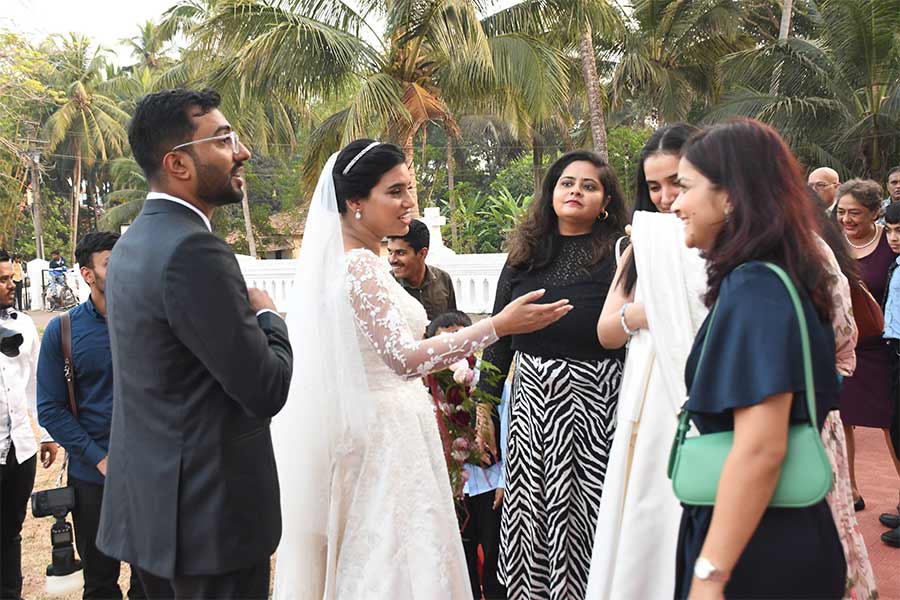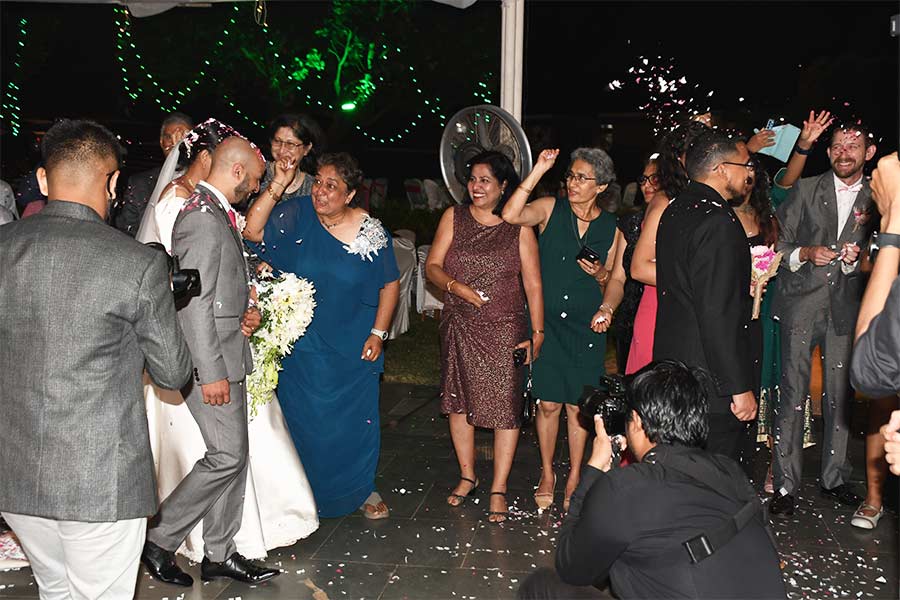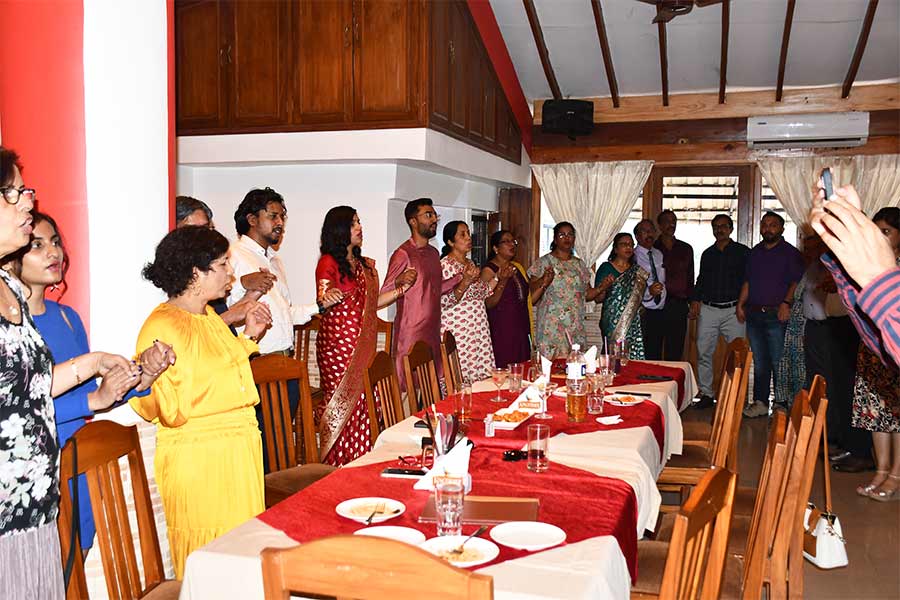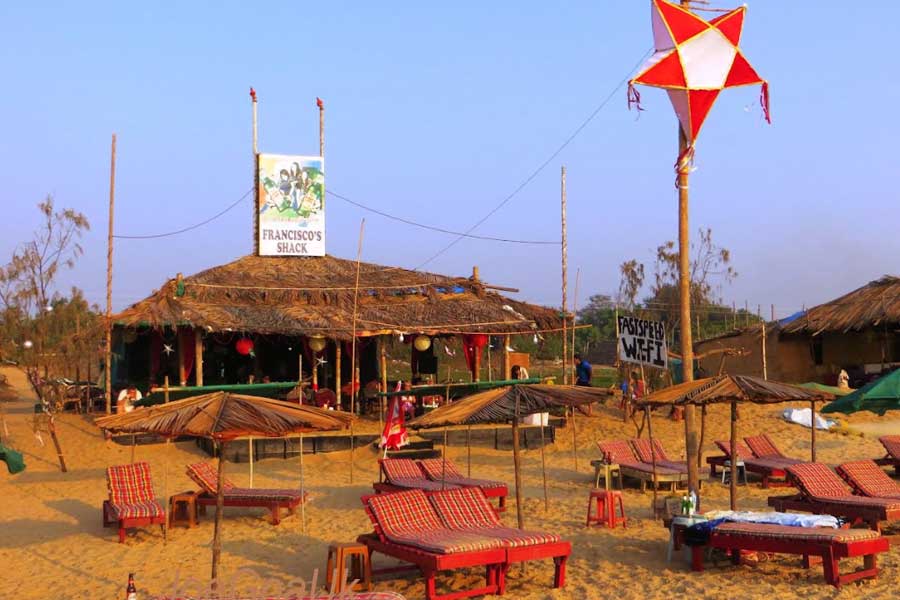Advertisements scream ‘Destination Wedding’ for Bangkok, Vietnam, and, of course, Goa. Most of these are five-star affairs – where affluent families book entire hotels and whisk everyone away for a few days of happy chaos. While for some it is a destination wedding, for others, like us non-resident Goans, it’s a return to our roots.
Pre-wedding prep: Coconut milk and Konkani beats
A few days before the wedding, Goans have the Roce ceremony – equivalent of the Haldi, or gaye halud ceremony for the Bengalis. The word roce being similar to ros of Bengali rosogolla fame, the bride-to-be, and often the groom-to-be too, are bathed in coconut milk while prayers and hymns are sung. Family members, in order of hierarchy, step up to pour a little of the roce on the soon-to-be wed couple.
The pre-wedding bachelorette and bachelor nights have survived the test of time. Fun games to get friends and family to meet and hang out together, well lubricated with beverages of every hue and potency! The big difference being the Goan folk songs, blessings and short speeches in Konkani. While the Shoe Game is usually reserved for receptions in Kolkata, here in Goa, we played them at the pre-wedding festivities.

Aman and Alisha play the 'Shoe Game'
Wedding day: From corsets to camera phones
Back in the ’70s, I found myself catapulted to instant (though short-lived) fame when I was the ‘chosen one’ to deliver jewellery from the groom’s side to the bride as she prepared for the big day. Being an eager-beaver, I arrived promptly at the bride’s house, only to be told to sit on the balcao, as the bride was yet to get past the corset stage! The sweltering heat of a Goan summer does not make for an ideal hang out in a full suit. With weddings becoming more cosmopolitan and urban, I suspect this quaint tradition has changed or vanished altogether. Nowadays, it’s more popular to have the exchange of garlands, tying of the mangalsutra and exchange of gold chains or rings, at the reception itself.
At the Wedding Mass in church, tradition once dictated that the groom wait in anticipation, checking his watch and sweating away while the bride took her own sweet time to arrive. Tradition even hinted at “bad luck” if the groom saw the bride the day before the actual wedding. Well bad luck to tradition itself! When we reached the church, well in time, the bride and groom were in the throes of a photoshoot outside the church. The groom then walked in confidently knowing his bride and her retinue would follow!
The church services are still traditional, meaningful and solemn. The choir adds ethereal music to the mix, with organ and violin accompaniment. The priest talks to the couple in the language of a layman. And the churchyard is the meeting place for family and friends, many of whom cannot make the reception but stick around after the service to meet and greet.

The couple meet-and-greet, after church services
The reception: Susegaad and selfies
Susegaad – a word loosely meaning “laid back” but embodying a far deeper essence of relaxed living. One bride and groom were from Mumbai. If one considers Kolkata's ‘slow life’ unfavourably, then the impact of Goa on individuals from Mumbai is undoubtedly profound. The bride was seen power-walking around the reception arena making sure everything was in place, even before officially entering.
Kolkata and Goa follow the normal order of events. The bridal couple enter the reception hall and parade around, with guests showering blessings on them in the form of confetti. They then move over to the cake – Goa has revolving tables for the cake, fortunately static while being cut. Saldanha Bakery from Kolkata made an impressive appearance at one Goa wedding, though the prepackaged cake slices were handed over in trendy gift bags as the venue insisted on serving their own crumbly cake.
The venue also provides all sorts of attractive photo ops, including selfie booths with messages of love, and Jenga blocks for guests to leave a message. Plus, a QR code for everyone to share their fun-filled moments through photo uploads!

One of the several selfie corners for couples
Evolution of entertainment: Saxophones to karaoke stars
The big difference I found was in the Grand March. In Kolkata weddings, this is held towards the end, when everyone forms an arch and the couple go through the arch – wishing everyone goodbye as they head out. In Goa, the Grand March was held in the beginning, after the first dance. The couple tends to be last to leave along with the family.
The emcees, too, are highly polished and practised. Pretty unlike our Kolkata local uncles or friends of the family who wing it on the fly. These MCs are well scripted, have their carefully rehearsed, ad hoc, one-liners popping up on their phones and deliver them with finesse. They do their homework on the two families, the toastmasters and even the band. And, unlike the local uncle and friend, they are paid heavily. They earn it.
Good old Mendelssohn’s Wedding March with all its saxophone and trumpet harmony has fallen by the wayside and is happily replaced by Gen Z++ music, which is meaningful and contemporary and eminently danceable – as displayed by bride and groom grooving into the hall rather than the stately “walk” – step left, pause, step right, pause (kick gown to avoid snagging).
There was a time when the wedding band was signed up based on the number of ‘pieces’ they had – including a saxophone, piano, trumpet, bass and drums. Bands have been replaced by singers and iPads, including the famous Facebook Lockdown stars Tammie and Roy and others like Tavi and Rochelle, Chelsea and Ansel who did a double take – in the church choir and at the reception too! The good old blowing instruments, with all their sax appeal, have been put to bed by karaoke technology.
The toast is raised in much the same way all over the country, but in Goa we had both the brides making their presence felt through messages to their families, husbands, friends and invitees. Both brides had their besties as toastmasters – a lot of woman power around. Champagne and sung blessings follow.
Remember the First Dance? It was literally a first for the couple, an awkward set of moves before they were saved by the parents stepping in. Today it is a beautifully choreographed extravaganza which is a joy to behold, in between the smoke machine, the laser lights, bubbles dropping from the ceiling and the recorded music.

Family and friends throw confetti on the couple during the 'Grand March'
Food, drink and dance: Chourice pao to champagne toasts
In both weddings, before the bridal couple’s grand entrance, mocktails and snacks were served. Snacks are pre-plated, culinary agnostic, heterogenous affairs, one for each person. You could find chourice paos (pork sausage between bread buns) jostling for plate space with prawn patties, corn canapes, cheese puffs, beef croquettes and tuna sandwiches – you just have to know what you are picking up. The buffet dinner is a multi-course, multi-cuisine affair which stretches across an entire hall. Something for everyone along with traditional Goan cuisine, neatly labelled with Portuguese or Konkani names that do not give away what’s inside. Either you know or you ask.
The bar, a focal point of any Goan wedding, offers all sorts of liquids to keep spirits high and feet moving on the dance floor.
Dance the evening away, not night. Goa Police has mandated that all music must be turned off by 10pm, which stretches to 10.30pm. So, for those who really must dance, the party shifts indoors, with a DJ. But dance, there must be!

A group dance is mandatory
Portone, the after-party
Similar to the bou bhat in Kolkata, here the father of the bride hosts a small after-party for the groom’s relatives the day after the wedding. The bride dresses in a resplendent sari or gown, generally red. But it does not involve a large crowd of well wishers as it’s an opportunity for branches of the family to get to know each other. The portone I attended was a beautiful affair where both families shared rituals, broke bread together and clicked a few selfies before bidding farewell, promising to stay in touch.
In a nutshell, Goa and Kolkata may take different paths in wedding customs, yet both cities embrace love and tradition in their own unique ways.

The 'portone' ceremony

